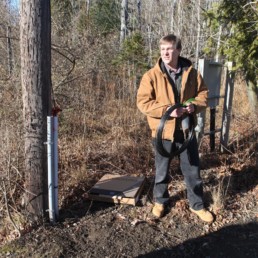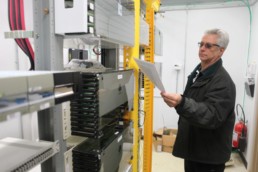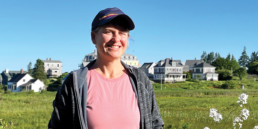Grabbing the Digital Future
Islands explore ways to bring fast internet to boost economies, support health care and education, and sustain population
By Jennifer Van Allen
Malcolm Fernald’s internet service has been just fast enough to maintain a web site for his family business, the Islesford Artists Gallery. But if a potential customer wants to get a closer look at a painting or two online, he’s out of luck.
“Trying to upload high-quality images to email to a person would either take forever or not happen at all,” says Fernald, 34, a lobsterman who is chairman of the board of selectmen for the town of Cranberry Isles.
For Fernald, even beyond boosting business, an internet upgrade is critical to sustaining the way of life that has always felt like a refuge for him, and to maintaining his family’s ties to Islesford that have endured for generations. He’s banking on fast, reliable internet service to open up new social and economic opportunities for the town and reduce its reliance on fishing and tourism.
“Our economy is very dependent on lobstering,” said Fernald, who also chairs the town’s citizen broadband task force. “While that’s been strong for the last 20 years, it’s never a guarantee.”
In early 2018, the town learned it had won a $1.3 million grant from USDA to build a broadband network that’s faster than the national average—with download speeds of 25 to 100 megabits per second (mbps) and upload speeds of 5 to 20 mbps. Installation began in late 2017.
Cranberry Isles is one of 34 Maine coastal and island communities actively pursuing improved internet speeds with the assistance of the Island Institute. The Institute hopes to get all of Maine’s 120 coastal and island communities connected to internet speeds that meet or exceed the national average by the year 2025.
“Broadband has emerged as critical to sustainability of island life,” said Briana Warner, economic development director for the Island Institute, publisher of Island Journal. “These people already have a geographic barrier. We want to make sure that a digital divide doesn’t make that barrier even bigger.”

Page Clason prepares to snake the fiber
through a conduit on Islesboro.
Internet access is notoriously poor in rural Maine—below the level that the ConnectME Authority defines as “broadband,” and far below the speed standard set by the Federal Communications Commission, which is 25 mpbs for downloads, and 3 mpbs for uploads.
“In Maine—and for the islands in particular—it’s one of the huge holes in our ability to move forward,” said U.S. Rep. Chellie Pingree, who is a member of the House Rural Broadband Caucus. Pingree lives on North Haven.
In November, Pingree cosponsored The Broadband Connections for Rural Opportunities Program Act, which would make grants available to rural areas, funding between 50 percent to 75 percent of a broadband project’s cost.
“If we want to be prosperous nationwide we have to make sure everyone down to the last mile gets it, and encourage more funds to go into these last miles.”
The importance of faster internet emerged during conversations Warner held with islanders about their economic development priorities.
While residents weren’t necessarily clamoring for broadband, said Warner, the needs they identified—better access to health- care, education, employment, new markets for small businesses, attracting more seasonal and year-round residents—all hinged on improved internet service.
“They were listing all these reasons why they were having problems, and they all led to the issue of terrible connectivity,” she said. Each community’s challenges are unique, but their stories about the digital divide are often the same.
Businesses couldn’t operate credit card machines. Artists who wanted to sell their goods online had to travel to the mainland to upload high-resolution photos. Summer visitors couldn’t extend their stays and potential new year-round residents were
Businesses couldn’t operate credit card machines. Artists who wanted to sell their goods online had to travel to the mainland to upload high-resolution photos. Summer visitors couldn’t extend their stays and potential new year-round residents were turned off because they couldn’t work remotely. Schoolchildren were sitting outside after dark doing homework on the steps of libraries—the only source of fast internet. The sick and elderly were having to make arduous trips to the mainland to see their doctors.
“A house without internet is like a house without running water.”
— ROGER HEINEN
“Years ago, people looking for houses would ask about taxes, heating, and utilities,” said Andrea Galuza, a real estate agent in Arrowsic. “Now their first question is ‘What’s the internet access like?’”
A powerful example has been set by Islesboro, which embarked on an internet upgrade before the Island Institute’s efforts began.
In 2016, Islesboro residents approved a $3.8 million bond to build a broadband internet network which will provide access of 1 gigabit per second—that’s 40 times faster than the broadband standard set by the FCC and 300 to 500 times faster than what’s affordable to islanders now. Though this fiber optic service could be considered overkill for today’s island internet needs, the system had to be designed and constructed to be viable for future generations.
The network is owned by the town and operated by GWI. All subscribers pay a fee of $30 per month to cover the cost of connectivity and support, while the town pays off the construction bond and maintains the network infrastructure—which will bring a property tax increase of about 8 percent.
To Arch Gillies, broadband is just as critical to sustainability as other initiatives now underway, like the new preschool, and changes to town laws designed to stimulate more affordable multifamily housing for residents.
“There’s a realization that if we don’t do these kinds of things, we’ll fall behind the Midcoast pretty quickly,” said Gillies, chairman of Islesboro’s select board and a member of the broadband committee. “All the islands have summer residents who are very important to their economies. You have to look to the day when all these economies have to be much more varied in the event that tastes shift, and people say they’d rather vacation in Nova Scotia, Florida, or Australia.”
Roger Heinen, a former senior executive at Microsoft, began advocating for widespread internet access when he moved to Islesboro in 1996.
“These people already have a geographic barrier. We want to make sure that a digital divide doesn’t make that barrier even bigger”
— BRIANA WARNER
Before the upgrade, he was relying on a pricey point-to-point radio link that allowed him to work remotely. “It was weather dependent and had all sorts of issues, and it cost several thousand dollars, but it made it possible for me to work from my house, which was essential,” he said.
But it bothered him that his solution was beyond what most islanders could afford. “It caused this terrible problem of haves and have nots,” Heinen said. “Internet is an essential part of life now. A house without internet is like a house without running water.”
That’s why an important principle of the island’s broadband plans was that all residents would pay the same rate and get the same level of service. Another key facet of the project was that it would be owned by the town and have on-island tech support from GWI.
“It means we control our destiny,” said Gillies. “If it’s owned by someone else, they can always decide that it’s not profitable, or that we wouldn’t get some new aspect of technology. Also, we felt that we could do this at a better price and ultimately have better service than we might have gotten otherwise.”
But even beyond that was maintaining their fierce sense of independence that has always been one of the most cherished qualities of island life.
“This had to be a local solution to a local problem,” said Heinen. “No one was going to come to our rescue. It needed to be solved, and we had to step up and do it ourselves.”
In 2015, the Island Institute hired Tilson Technologies to assess internet infrastructure on 13 year-round islands, plus the seasonal Sutton Island, part of the Cranberry Isles. The study gauged how much residents were paying, how satisfied they were, and identified possible upgrades.

Roger Heinen in the building on Islesboro
that houses all customer fiber lines.
The Institute also held a broadband summit to help community leaders learn, network, and strategize. Since then, the Institute has been providing a wide variety of support services that include helping community leaders: write grants, research financing options, negotiate with internet service providers, and form municipally-authorized broadband task forces. The Institute also has awarded planning grants of up to $10,000 to fund engineered infrastructure designs that communities can put out to bid.
“We’re trying to fill whatever gaps the community has to help keep the projects moving,” said Stephenie MacLagan, an economic development associate at the Institute.
For the 3 Bridged Island Task Force that includes Arrowsic, Georgetown, and Southport, all three towns financially supported an engineering study, which was matched by a planning grant from the Island Institute.
On Vinalhaven, the Institute cosponsored a digital education workshop to increase know-how on programs like Quick Books. Events like this are often held at the public library, which has internet that’s 100 times faster than what they have at their homes. Even beyond showing residents how to reach more customers and work more efficiently, “These workshops show what’s possible with broadband,” MacLagan said.
But even without the Institute’s assistance, community leaders have pursued internet upgrades at a pace that has surpassed all expectations.
“Initially we thought a few communities would take it up, but it would be a long, hard slog,” said Warner. “Now 34 communities are actively pursuing better broadband. Our basic aspirations have been blown out of the water. These communities are taking control of their own digital futures. But they’re used to that. As islanders, they’ve had to do that forever.”
Even in areas where internet providers have made upgrades, longer-term solutions are being pursued. In the Hancock County town of Brooklin, Fairpoint upgraded DSL system in 2017 to provide 25/3 service.
“Fairpoint’s efforts have taken care of much of us for the short term,” said Bill Cohen, chairman of the board of selectmen in Brooklin. “The question is, what do we want as a community to position ourselves for 20 years out?”
Cohen sees broadband as a key to attracting more families and bolstering enrollment in local schools.
“We have been seeing a stagnation of young people moving into the community,” said Cohen, who is chair of the Brooklin Broadband Committee. “Local education is part of our vitality. But the fewer kids you have, the more expensive it is. And the less diverse.”
While many residents surveyed by Tilson for the Island Institute said they would be willing to pay more for better internet access, in some cases they may end up paying less than the expensive workarounds they’re paying for now. In the town of Cranberry Isles, the upgraded service will be available in three levels, for $65, $75, or $100 a month for residents. Though Fernald would pay at least $23 more a month for internet than he is paying now, and he estimates his property taxes will be about $17 a month higher to pay for the infrastructure, the upgrades will allow him to cut expenses elsewhere.
For example, the upgraded service is expected to be fast enough for VOIP (Voice Over Internet Protocol), so he’ll be able to use it to make calls, which means he will be able to cancel his landline. He’ll be able to stream his favorite shows, and eventually get rid of satellite TV, which costs $100 a month.
In Georgetown, Mark Aukeman, who works remotely as a technology consultant, was paying $175 per month to rent office space in Bath—just for internet service. Whatever the new system costs, said Aukeman, who chairs the 3 Bridged Islands Broadband Task Force, “It’s still going to be cheaper than renting an office.”






